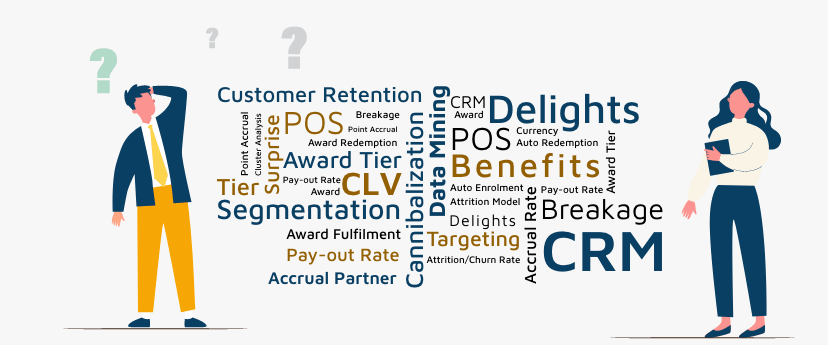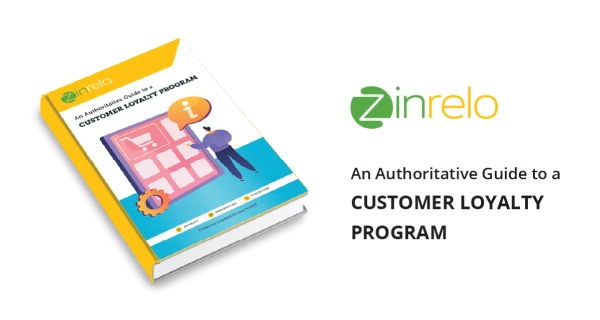A | B | C | D | E | F | G | H | I | J | K | L | M | N | O | P | Q | R | S | T | U | V | W | X | Y | Z
A

Accrual Rate
The rate at which customers earn points in a program. For example, earn 1 point for every $1 spent.

Accrual Partner
A partner that purchases points in a sponsor’s program. For example, when credit cards offer airline points to their cardholders – the credit card pays the airline for points issued.

Attrition Model
An attrition model predicts which customers are most likely to discontinue use of a company’s goods or services.

Attrition/Churn Rate
The rate of fall-off in regular respondents, or the percentage of customers this year who are no longer a customer next year.

Appreciation Gifts a.k.a Surprise and Delights
Rewards that are sent to customers without “earning them” through points or other specific behaviors. The customer is not expecting the gift. e.g. customers are sent a local coupon booklet of restaurant discount coupons, cleaning coupons and other entertainment coupons.

Award Fulfillment
The process by which awards are requested by or issued to a customer.

Auto Enrollment
Customers are enrolled into a program without requesting to be involved in the program.

Auto Redemption
When a program member’s account balance reaches a specific threshold of points, a reward is automatically generated. This is a passive reward since the member does not choose to receive it.

Award
An item that is purchased by the exchange of points or program currency.

Aspirational Award
These are generally travel or luxury goods that a customer will “aspire to,” and thus motivate desired changes in behavior. Generally, high in perceived value.
B

Back end and front end
Loyalty programs are generally divided into front end and back end activities. The front end refers to all process that relate to point earning and accrual. For example, the front end tracks transactions and sets the value of a point at issuance in terms of the earning rate(s), such as 1 point earned for every $1 spent. The back end refers to all processes that relate to point redemption. For example, back end processes are responsible for award fulfillment and setting the value of points on the reward side.

Behavior, Current & Desired
Customer behaviors are closely monitored by loyalty program managers and evaluated in terms of changes between current and desired behaviors. Current behaviors refer to what a company’s customers are doing now, such as frequency of purchase, purchase characteristics and trends in behavioral segments. Desired behaviors represent what the company wants its customers to do in the future, such as spend more or purchase more frequently.

Benefits
Ongoing privileges of being a member of a program. These may include express lines for program members and invitations to members-only events. Benefits help a customer feel recognized for their patronage. Also known as Customer Benefits.

Breakage
The difference between points issued and points redeemed. Breakage may occur from participants who drop out of or lose interest in a program, expiration of points or point balances that are beneath the first award level.

Burn, Open & Closed
The consumption of loyalty program currency to obtain reward benefit. Open burn refers to the ability of a participant to redeem for rewards from several companies. Closed burn means that reward options are limited to only those that the sponsoring company provides. For example, if airlines only offered airline rewards, that would be an example of a closed burn; when the airlines began offering awards from hotels, cruises, retail merchants, et al, it became an open burn.
C

Cannibalization
The act of rewarding customers for behaviors that did not need to be rewarded. For example, many companies cannibalize existing versus incremental customer spend.

Call to Action
What the customer is instructed to do by the communications campaign. This may include sharing on social media platforms, stopping by or visiting a web site to enrol in the program, referring a friend, completing a survey etc.

Closed-Loop Analysis
A continuous improvement process in which data analysis, campaign planning and customer interaction are combined in a virtuous “closed loop” where execution of the campaign through customer interaction produces metrics that can be further analyzed for better campaign planning.

Cluster Analysis
List analysis technique examining geographic, demographic or psychographic characteristics. Defined as the process of dividing data into groups (clusters) to meet the objectives of a particular application

CLV – Customer Lifetime Value
The stream of expected future profits, net of costs, on a customer’s transactions, discounted at some appropriate rate back to its current, net present value.

Control Group
Core group of target population that would be interested in general promotion but is not exposed to the current promotion. Use of a control group allows program managers to detect the incremental impact of a program or a promotion by measuring the behavior of respondents versus the control group. This is used for A/B testing.

C.R.M. (Customer Relationship Management)
How a company manages the relationships it has established with its customers. Ideally, it’s a comprehensive, well-planned and executed approach to retaining customers through good customer service and support.

Currency
The exchange mechanism that allow a participant to swap equity (earnings) into an award. Types of currency may include points, miles, credits, rebate dollars or other.

Customer retention
It is the ability to sell to customers who have already made purchases. Your retention metric is about turning new customers into repeat customers which makes it a useful metric to measure and track.

Customer Segmentation
The grouping of customers into geo-demographic segments including such factors as age, spending, location, income, psychographics, purchase profiles or combinations thereof.

Customer Value
Determination of customer value varies by company and industry. Most of the time customer value is calculated based upon some measure of recency and frequency of purchase, tenure (length as a customer) and the amount the customer has spent in each period. To determine a customer’s potential for incremental performance, that customer’s current value statistics will be matched against the average for his/her cohort group. The difference between the two represents the customer’s potential for a positive lift in value.
D

Data Mining
The process of using software tools to sift through large amounts of information in a database to find patterns, groups, statistical correlations, and relationships. Also, the process of utilizing the results of data exploration to adjust or enhance business strategies.

Direct Marketing
Any advertising activity which creates and exploits a direct relationship between you and your prospect or customer as an individual.
E

Earn, Open & Closed
Earn is a term used to reference how a customer accrues equity in a program. Open earn refers the accumulation of points or other currency from any participating source or partner within the program, whereas closed earn is restricted to the accumulation of currency only from within the participating source.

Enrolment / Re-enrolment
Becoming an “active” member in a customer loyalty program. Often performed online, through call centres, or at the point of purchase, enrolment makes the customer eligible for the benefits of the loyalty programs. Such membership may expire over time due to non-use at which point re-enrolment may be required for further program participation.

Equity
The amount a participant has earned that is translated into points or another program currency.

Event-driven Programs
Database programs that are triggered to produce communications based on events such as birthdays, anniversaries, thank you letters, etc. or signals of imminent attrition.
F

Financial Model
A financial model is essentially the pro forma for the program. It projects enrolment, administrative costs, points accrued, points redeemed and the program’s ROI on a one- to five-year basis.

Frequency Marketing a.k.a. Loyalty Marketing, Relationship Marketing
Any sales or marketing strategy that rewards loyal customers for their repeat business. Typically, involves point accrual based on the customers’ transactions or activities and the exchange of those accrued points for incentives such as free or discounted goods and services and/or enhanced levels of service; identifying, maintaining and increasing the yield from best customers through long-term interactive value-added relationships.
H-I

Hard Benefit
A tangible reward, which may be earned in its entirety, which requires the program sponsor to spend out-of-pocket dollars to provide it, and for which the member would otherwise have to pay. (Do X…get Y, such as travel, merchandise, gift certificates, rebate checks or experiences.

High Value Customer
An economic view of a customer that measures how profitable the customer is to the company, instead of measuring the profitability of product or service lines. Customer relationship management is geared towards optimizing the value of each customer.

In-Kind Rewards
The host company’s own products and services. For example, free product or a sample.

Invisible Points
Offers/rewards of which customers are unaware of the accumulation. Used for scoring based on behavior/profit margin of purchase.
L-M

Liability
As points are issued by a program, a percentage of their total value is recorded on the company’s balance sheet as a liability. The points issued that is recorded, reflects the total points issued minus estimated breakage. As points are redeemed, points are retired on a company’s income statement as an expense, and the balance sheet liability is reduced accordingly.

Member Tier (Recognition Level)
A customer may be placed in a special member group or tier based on their volume of purchases, value contribution or account lifetime value. In addition to offering a higher level of customer service, such member tiers typically afford greater rates of point accrual, more advantageous point exchange rates for awards and less restrictive expiration and re-enrolment policies. Often members in elite tiers must maintain a specified level of purchases within the calendar year to re-qualify for that recognition level in the following year.
O

On-Demand Redemption
As opposed to automatic redemption, customers request an award at a time of their own choosing over the telephone, via fax or internet.

Open Economy
Equity programs whose hard benefits include products and services other than and/or in addition to the sponsor’s product/service; currency of the reward program moves in and out of the program as opposed to the currency staying between the company and the customer.

Open Enrollment
Anyone can enrol in the program, but the individual must choose to opt into the program.
P

Pay-out Rate
Funding rate. For example, if 1 point is earned per every dollar spent, and if every point is worth 1 cent, then the pay-out rate is 1% of all purchases.

Perceived Value
How awards are valued by the customer. For example, a $50 gift certificate would have a perceived value of $50, whereas a concert with backstage passes to meet the band would be perceived much higher than the face value of the tickets.

Points
Units of currency used to signify the amount of customer equity earned by participating in a program.

Point Caps
The amount of points a customer can earn each time for specific activities can be limited, or “capped.” This can help limit fraudulent practices by participants.

Point Accrual
The predetermined means by which members within a Loyalty Program accrue program currency as an incentive or reward for purchasing products and services.

Point Expiration
The automatic deduction of unused program currency from the member’s account for non-use. Frequency Marketers use point expiration policies to cap future point-related liabilities. Point expiration is sometimes referred to as breakage.

POS (Point of sale)
At a retail location, POS represents a device or system to capture transactions at the time of sale.
R

Recency
Is a measurement of when the customer last interacted with program in a recorded event such as visited the website, making a purchase, calling the customer contact center etc. Recency is usually considered the strongest predictor of future buyer behavior.

Recognition
The act of recognizing and thanking customers for their patronage. Recognition may include preferred program status, expedited handling, appreciation gifts, etc. The goal of recognition is to make customers feel special and appreciated.

Redemption
The process of exchanging program currency for an award.

Relationship Marketing
Building relationships with customers so that the customers are loyal, buy repeatedly, and stay on as customers. Database marketing that stresses customer retention over acquisition.

Reward
An item of value that is exchanged for points or offered as compensation for completion of desired behaviors.

Rewards Earning Ratio
The amount of time it takes a typical customer to earn an award.

Rules Engine
A set of instructions that awards points based upon a selected set of desired behaviors. Also converts spending volume into point values.
S-T

Segment Mobility
The ability to move customers within one performance category into another, more profitable category. For example, migrating occasional users to frequent users is one example of segment mobility.

Soft Benefit
An intangible consideration extended to a member as evidence of the member’s special status, and it usually takes the form of some sort of special treatment (special access, special deals/ discounts, special experiences), often requiring little or no out-of-pocket funding by the sponsor.

Targeting
Selection of best customer prospects to fulfil specific company objectives.

Tier Mobility
The movement of customers between membership tiers. Tiers are often assigned on reaching a specific number of points.
U-V

Upselling Ratio
Upsell conversion rates track the number of purchases that customers make above and beyond the initial product they set out to buy.

Value-at-Risk Customers
Any high-value, high-yield customer with a high propensity to churn. Often Frequency Marketers give extra weighting to Value-at-Risk customers in policy planning and award budget allocations.

Vested Equity
A lump sum of points given to a customer upfront that can only be used as time passes or the desired behavior is exhibited. For example, “Points awarded for account creation.

Value Added Proposition
Managing and enhancing the value to both the customer and the company within the relationship.




